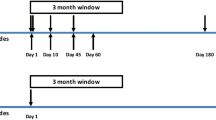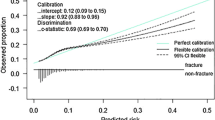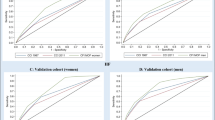Abstract
Summary
Physician-billing claims databases can be used to determine the incidence of fractures in the community. This study tested three algorithms designed to accurately and reliably identify fractures from a physician-billing claims database and concluded that they were useful for identifying all types of fractures, except vertebral, sacral, and coccyx fractures.
Introduction
To develop and validate algorithms that identify fracture events from a physician-billing claims database (PCDs).
Methods
Three algorithms were developed using physician’s specialty, diagnostic, and medical service codes used in a PCD from the province of Quebec. Algorithm validity was assessed via calculation of positive predictive values (PPV; via verification of a sample of algorithm-identified cases with hospitalization files) and sensitivities (via cross-referencing respective algorithm-identified fracture cases with a well-characterized fracture cohort).
Results
PPV and sensitivity varied across fracture sites. For most fracture sites, the PPV with algorithm 3 was higher than with algorithms 1 or 2. Except for knee fracture, the PPVs ranged from 0.81 to 0.96. Sensitivities were low at the vertebral, sacral, and coccyx sites (0.40–0.50), but high at all other fracture sites. For 95% of fractures, the fracture site identified by algorithm agreed with the fracture site from patients’ medical records. Fracture dates identified by algorithm were within 2 days of the actual fracture date in 88% of fracture cases. Among cases identified by algorithm 3 to have had an open reduction (N = 461), 95% underwent surgery according to their respective medical charts.
Conclusion
Algorithms using PCDs are accurate and reliable for identifying incident fractures associated with osteoporosis-related fracture sites. The identification of these fractures in the community is important for helping to estimate the burden associated with osteoporosis and the utility of programs designed to reduce the rates of fragility fracture.


Similar content being viewed by others
References
(1993) Consensus development conference: diagnosis, prophylaxis, and treatment of osteoporosis. Am J Med 94(6):646–650
Melton LJ III, Chrischilles EA, Cooper C, Lane AW, Riggs BL (1992) Perspective. How many women have osteoporosis? J Bone Miner Res 7:1005–1010
Bessette L, Ste-Marie LG, Jean S, Davison KS, Beaulieu M, Baranci M, Bessant J, Brown JP (2008) The care gap in diagnosis and treatment of women with a fragility fracture. Osteoporos Int 19:79–86
Cooper C (1997) The crippling consequences of fractures and their impact on quality of life. Am J Med 103:12S–17S
Ioannidis G, Papaioannou A, Hopman WM, khtar-Danesh N, Anastassiades T, Pickard L, Kennedy CC, Prior JC, Olszynski WP, Davison KS, Goltzman D, Thabane L, Gafni A, Papadimitropoulos EA, Brown JP, Josse RG, Hanley DA, Adachi JD (2009) Relation between fractures and mortality: results from the Canadian Multicentre Osteoporosis Study. CMAJ 181:265–271
Melton LJ III (2003) Adverse outcomes of osteoporotic fractures in the general population. J Bone Miner Res 18:1139–1141
Burge R, wson-Hughes B, Solomon DH, Wong JB, King A, Tosteson A (2007) Incidence and economic burden of osteoporosis-related fractures in the United States, 2005-2025. J Bone Miner Res 22:465–475
Elliot-Gibson V, Bogoch ER, Jamal SA, Beaton DE (2004) Practice patterns in the diagnosis and treatment of osteoporosis after a fragility fracture: a systematic review. Osteoporos Int 15:767–778
Giangregorio L, Papaioannou A, Cranney A, Zytaruk N, Adachi JD (2006) Fragility fractures and the osteoporosis care gap: an international phenomenon. Semin Arthritis Rheum 35:293–305
Papaioannou A, Giangregorio L, Kvern B, Boulos P, Ioannidis G, Adachi JD (2004) The osteoporosis care gap in Canada. BMC Musculoskelet Disord 5:11-
Cadre et stratégie de prévention et de gestion de l’ostéoporose. Conseil ontarien des services de santé pour les femmes 2000. 2000; 49
Report of the Surgeon General’s workshop on osteoporosis and bone health. U.S. Department of health and Human Services. 2005; 55
Lippuner K, Golder M, Greiner R (2005) Epidemiology and direct medical costs of osteoporotic fractures in men and women in Switzerland. Osteoporos Int 16(Suppl 2):S8–S17, Epub 2004 Sep 16: S8–S17
Klotzbuecher CM, Ross PD, Landsman PB, Abbott TA III, Berger M (2000) Patients with prior fractures have an increased risk of future fractures: a summary of the literature and statistical synthesis. J Bone Miner Res 15:721–739
Lix LM, Yogendran MS, Leslie WD, Shaw SY, Baumgartner R, Bowman C, Metge C, Gumel A, Hux J, James RC (2008) Using multiple data features improved the validity of osteoporosis case ascertainment from administrative databases. J Clin Epidemiol 61:1250–1260
Zuckerman IH, Sato M, Hsu VD, Hernandez JJ (2007) Validation of a method for identifying nursing home admissions using administrative claims. BMC Health Serv Res 7:202
Ray WA, Griffin MR, Fought RL, Adams ML (1992) Identification of fractures from computerized Medicare files. J Clin Epidemiol 45:703–714
Potter BK, Manuel D, Speechley KN, Gutmanis IA, Campbell MK, Koval JJ (2005) Is there value in using physician billing claims along with other administrative health care data to document the burden of adolescent injury? An exploratory investigation with comparison to self-reports in Ontario, Canada. BMC Health Serv Res 5:15-
Dendukuri N, McCusker J, Bellavance F, Cardin S, Verdon J, Karp I, Belzile E (2005) Comparing the validity of different sources of information on emergency department visits: a latent class analysis. Med Care 43:266–275
Kostylova A, Swaine B, Feldman D (2005) Concordance between childhood injury diagnoses from two sources: an injury surveillance system and a physician billing claims database. Inj Prev 11:186–190
Wilchesky M, Tamblyn RM, Huang A (2004) Validation of diagnostic codes within medical services claims. J Clin Epidemiol 57:131–141
Tamblyn R, Reid T, Mayo N, McLeod P, Churchill-Smith M (2000) Using medical services claims to assess injuries in the elderly: sensitivity of diagnostic and procedure codes for injury ascertainment. J Clin Epidemiol 53:183–194
Monfared AA, LeLorier J (2006) Accuracy and validity of using medical claims data to identify episodes of hospitalizations in patients with COPD. Pharmacoepidemiol Drug Saf 15:19–29
Levy AR, Mayo NE, Grimard G (1995) Rates of transcervical and pertrochanteric hip fractures in the province of Quebec, Canada, 1981-1992. Am J Epidemiol 142:428–436
Sattin RW, Lambert Huber DA, DeVito CA, Rodriguez JG, Ros A, Bacchelli S, Stevens JA, Waxweiler RJ (1990) The incidence of fall injury events among the elderly in a defined population. Am J Epidemiol 131:1028–1037
Bessette L, Ste-Marie LG, Jean S, Davison KS, Beaulieu M, Baranci M, Bessant J, Brown JP (2008) Recognizing osteoporosis and its consequences in Quebec (ROCQ): background, rationale, and methods of an anti-fracture patient health-management programme. Contemp Clin Trials 29:194–210
Mackey DC, Lui LY, Cawthon PM, Bauer DC, Nevitt MC, Cauley JA, Hillier TA, Lewis CE, Barrett-Connor E, Cummings SR (2007) High-trauma fractures and low bone mineral density in older women and men. JAMA 298:2381–2388
Curtis JR, Taylor AJ, Matthews RS, Ray MN, Becker DJ, Gary LC, Kilgore ML, Morrisey MA, Saag KG, Warriner A, Delzell E (2009) “Pathologic” fractures: should these be included in epidemiologic studies of osteoporotic fractures? Osteoporos Int 20:1969–1972
Kanis JA, Oden A, Johnell O, Jonsson B, de Laet C, Dawson A (2001) The burden of osteoporotic fractures: a method for setting intervention thresholds. Osteoporos Int 12:417–427
(2010) Régie de l’assurance maladie du Québec. Outils de recherche de l’information statistique (ORIS). www.ramp.gouv.qc.ca. Accessed 1 May 2010
Bernard P, LaPointe C (1995) Mesure statistique en épidémiologie. 175–190
Altman DG, Bland JM (1994) Diagnostic tests 2: predictive values. BMJ 309:102-
Altman DG, Bland JM (1994) Diagnostic tests. 1: sensitivity and specificity. BMJ 308:1552-
Biggerstaff BJ (2000) Comparing diagnostic tests: a simple graphic using likelihood ratios. Stat Med 19:649–663
Curtis JR, Mudano AS, Solomon DH, Xi J, Melton ME, Saag KG (2009) Identification and validation of vertebral compression fractures using administrative claims data. Med Care 47:69–72
Pentek M, Horvath C, Boncz I, Falusi Z, Toth E, Sebestyen A, Majer I, Brodszky V, Gulacsi L (2008) Epidemiology of osteoporosis related fractures in Hungary from the nationwide health insurance database, 1999–2003. Osteoporos Int 19:243–249
Lentle BC, Brown JP, Khan A, Leslie WD, Levesque J, Lyons DJ, Siminoski K, Tarulli G, Josse RG, Hodsman A (2007) Recognizing and reporting vertebral fractures: reducing the risk of future osteoporotic fractures. Can Assoc Radiol J 58:27–36
Cataldi V, Laporta T, Sverzellati N, De FM, Zompatori M (2008) Detection of incidental vertebral fractures on routine lateral chest radiographs. Radiol Med 113:968–977
Acknowledgments
This work was funded by an unrestricted grant from Servier Canada Inc. It is also part of the study Recognizing Osteoporosis and its Consequences in Québec (ROCQ), which has been made possible through the support of founding partners Merck Canada, Sanofi-Aventis Canada Inc., and Warner Chilcott, as well as major partner Amgen Canada Inc. and minor partners Eli Lilly Canada Inc. and Novartis Pharma Canada Inc.
We would like to acknowledge the important contribution of medical archivist Karine Picard who conducted the review of cases in hospitals’ medical records and Dr. K. Shawn Davison for revision of the manuscript.
Conflicts of interest
None.
Author information
Authors and Affiliations
Corresponding author
Appendix 1
Appendix 1
Rights and permissions
About this article
Cite this article
Jean, S., Candas, B., Belzile, É. et al. Algorithms can be used to identify fragility fracture cases in physician-claims databases. Osteoporos Int 23, 483–501 (2012). https://doi.org/10.1007/s00198-011-1559-4
Received:
Accepted:
Published:
Issue Date:
DOI: https://doi.org/10.1007/s00198-011-1559-4




